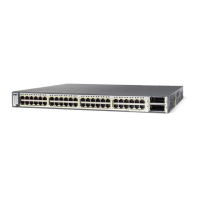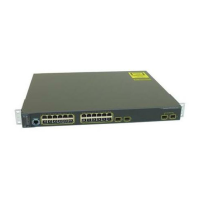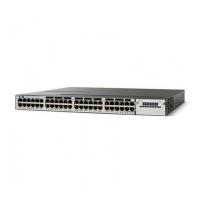42-45
Catalyst 3750-X and 3560-X Switch Software Configuration Guide
OL-21521-01
Chapter 42 Configuring IP Unicast Routing
Configuring BGP
In BGP, each route consists of a network number, a list of autonomous systems that information has
passed through (the autonomous system path), and a list of other path attributes. The primary function
of a BGP system is to exchange network reachability information, including information about the list
of AS paths, with other BGP systems. This information can be used to determine AS connectivity, to
prune routing loops, and to enforce AS-level policy decisions.
A router or switch running Cisco IOS does not select or u
se an IBGP route unless it has a route available
to the next-hop router and it has received synchronization from an IGP (unless IGP synchronization is
disabled). When multiple routes are available, BGP bases its path selection on attribute values. See the
“Configuring BGP Decision Attributes” section on page 42-52 for information about BGP attributes.
BGP Version 4 supports classless interdomain routing (CIDR)
so you can reduce the size of your routing
tables by creating aggregate routes, resulting in supernets. CIDR eliminates the concept of network
classes within BGP and supports the advertising of IP prefixes.
These sections contain this co
nfiguration information:
• Default BGP Configuration, page 42-45
• Enabling BGP Routing, page 42-48
• Managing Routing Policy Changes, page 42-50
• Configuring BGP Decision Attributes, page 42-52
• Configuring BGP Filtering with Route Maps, page 42-54
• Configuring BGP Filtering by Neighbor, page 42-54
• Configuring Prefix Lists for BGP Filtering, page 42-56
• Configuring BGP Community Filtering, page 42-57
• Configuring BGP Neighbors and Peer Groups, page 42-58
• Configuring Aggregate Addresses, page 42-60
• Configuring Routing Domain Confederations, page 42-61
• Configuring BGP Route Reflectors, page 42-61
• Configuring Route Dampening, page 42-62
• Monitoring and Maintaining BGP, page 42-63
For detailed descriptions of BGP configuration, se
e the “Configuring BGP” chapter in the “IP Routing
Protocols” part of the Cisco IOS IP Configuration Guide, Release 12.2. For details about specific
commands, see the Cisco IOS IP Command Reference, Volume 2 of 3: Routing Protocols, Release 12.2.
For a list of BGP commands that are visible but not supported by the switch, see Ap
pendix C,
“Unsupported Commands in Cisco IOS Release 12.2(53)SE2.”
Default BGP Configuration
Table 42-9 shows the basic default BGP configuration. For the defaults for all characteristics, see the
specific commands in the Cisco I
OS IP Command Reference, Volume 2 of 3: Routing Protocols,
Release 12.2.
